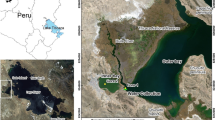Abstract
Sediment and peat accumulation rates as well as heavy metal fluxes are examined in Scandinavian lakes, marine coasts and peatlands. Modern accumulation rates are determined using Pb-210 and other chronological tools. Mean deposition rates in the past 150 ± 20 yrs are 3–95, 40–190 and 1–5 mg·cm−2·yr−1 for lakes, marine coasts and peatlands respectively. The Pb-210 fluxes at the investigated sites are quite variable. The lowest values are found for peatlands 0.04–0.20 pCi·cm−2·yr−1 while coastal marine environments showed 0.35–0.70 pCi·cm−2·yr−1. A wide range of variation of Pb-210 fluxes is obtained for the studied lake sediments 0.01–0.51 pCi·cm−2·yr−1.
The chronological records of Pb, Zn, Cu, Cd and Hg show that heavy metal fluxes are much higher in coastal marine areas. Inland lakes and ombrotrophic peat-bogs indicate that Pb is introduced exclusively through the atmosphere and decrease exponentially from South to North Scandinavia. However, the other heavy metals are transported to freshwater systems by different hydrologic and atmospheric processes. Zn and Fe exhibit some correlation with lake-drainage area.
Similar content being viewed by others
References
Alderton, D. H. M., 1985. Sediments. In MARC report 31, Historical Monitoring. University of London; Lond.: 1–95.
Battarbee, R. C. & G. Digerfeldt, 1976. Palaeoecological studies of the recent development of Lake Växjösjön. Arch. Hydrobiol. 77: 330–346.
Chanton, J. P., G. S. Martens & G. W. Kipput, 1983. Lead-210 sediment geochronology in a changing coastal environment. Geochim. Cosmochim. Acta 47: 1791–1804.
Davis, A. O., J. N. Galloway & D. K. Nordstrom, 1982. Lake acidification: Its effect on lead in the sediment of two Adirondack lakes. Limnol. Oceanogr. 27: 163–167.
Edberg, N., 1980. Ålderbestämning av sediment med 137Cs. Tillämpningar och problem. In F. Ø. Andersen, L. H. Kofoed & E. Lastein (eds), The 8th Nordic Symposium on Sediments. Biological Institute, Odense University, Odense: 20–30.
El-Daoushy, M. F. A. F., 1978. The determination of Pb-210 and Ra-226 in lake sediments and dating applications. Uppsala University Institute of Physics Reports, Uppsala: UUIP-979, 45 pp.
El-Daoushy, M. F. A. F., 1981a. Stability of two silicon detectors in low-level alpha counting. In: Methods of Low-level Counting and Spectrometry, I.A.E.A., Vienne: 151–160.
El-Daoushy, M. F. A. F., 1981b. An ionization chamber and a Si-detector for lead-210 chronology. Nucl. Instr. Methods 188: 647–656.
El-Daoushy, F., 1986. The value of 210Pb in dating Scandinavian aquatic and peat deposits. Radiocar. 28 (in press).
El-Daoushy, F. & K. Johansson, 1983. Radioactive lead-210 and heavy metal analyses in four Swedish lakes. Ecol. Bull. (Stockholm) 35: 555–570.
El-Daoushy, F. & K. Tolonen, 1984. Lead-210 and heavy metal contents in dated ombrotrophic peat hummocks from Finland. Nucl. Instr. Meth. Res. 223: 392–399.
Evans, R. D. & F. H. Rigler, 1983. A test of 210Pb dating for the measurement of whole lake soft sediment accumulation. Can. J. Fish. aquat. Sci. 40: 506–515.
Franzén, L., 1985. Peat in Sweden — a method to calculate the resources (Thesis). Department of Physical Geography, University of Göteborg, Göteborg: 241 pp.
Goldberg, E. D., 1963. Geochronology with lead-210. In: Radioactive Dating, I.A.E.A., Vienne: 121–131.
Jacobsen, O. S., 1981. The historical development of air pollution as reflected in ombrotrophic peat bogs in Denmark. In: Proc. Inter. UNEP-SCOPE Meet., Dynamics of Wetlands and Shallow Water Bodies, USSR, 1981.
Johansson, K., 1980. Tungmetaller i sura skogssjöar. The National Swedish Environment Protection Board, SNV-PM 1359, Solna: 70 pp. [In Swedish, English Summary].
Krishnaswami, S. & D. Lal, 1978. Radionuclide limnochronology. In A. Lerman (ed.), Lakes: Chemistry, Geology, Physics. Springer-Verlag, N.Y.: 153–177.
Lewis, D. M., 1977. The use of 210Pb as a heavy metal tracer in the Susquehanna River system. Geochim. Cosmochim. Acta 41: 1557–1564.
McCaffrey, R. J. & J. Thomson, 1980. A record of the accumulation of sediment and trace metals in a connecticut salt marsh. Adv. Geophys. 22: 165–236.
Oldfield, F. & P. G. Appleby, 1984. Empirical testing of 210Pb-dating models for lake sediments. In E. Y. Haworth & J. W. G. Lund (eds), Lake Sediments and Environmental History. Leicester University Press, Leicester: 93–124.
Olsson, I. U., F. El-Daoushy & Y. Vasari, 1983. Säynäjälampi and the difficulties inherent in dating of sediments in a hardwater lake. Hydrobiologia 103: 5–14.
Petit, D., 1974. 210Pb et isotopes stables du plomb dans des sediments lacustres. Earth Planet. Sci. Lett. 23: 199–205. [In French, English summary].
Robbings, J. A., 1978. Geochemical and geophysical applications of radioactive lead. In J. O. Nriagu (ed.), The Biogeochemistry of Lead in the Environment, Part A. Elsevier, Amsterdam: 285–393.
Author information
Authors and Affiliations
Rights and permissions
About this article
Cite this article
El-Daoushy, F. Scandinavian limnochronology of sediments and heavy metals. Hydrobiologia 143, 267–276 (1986). https://doi.org/10.1007/BF00026670
Accepted:
Issue Date:
DOI: https://doi.org/10.1007/BF00026670




